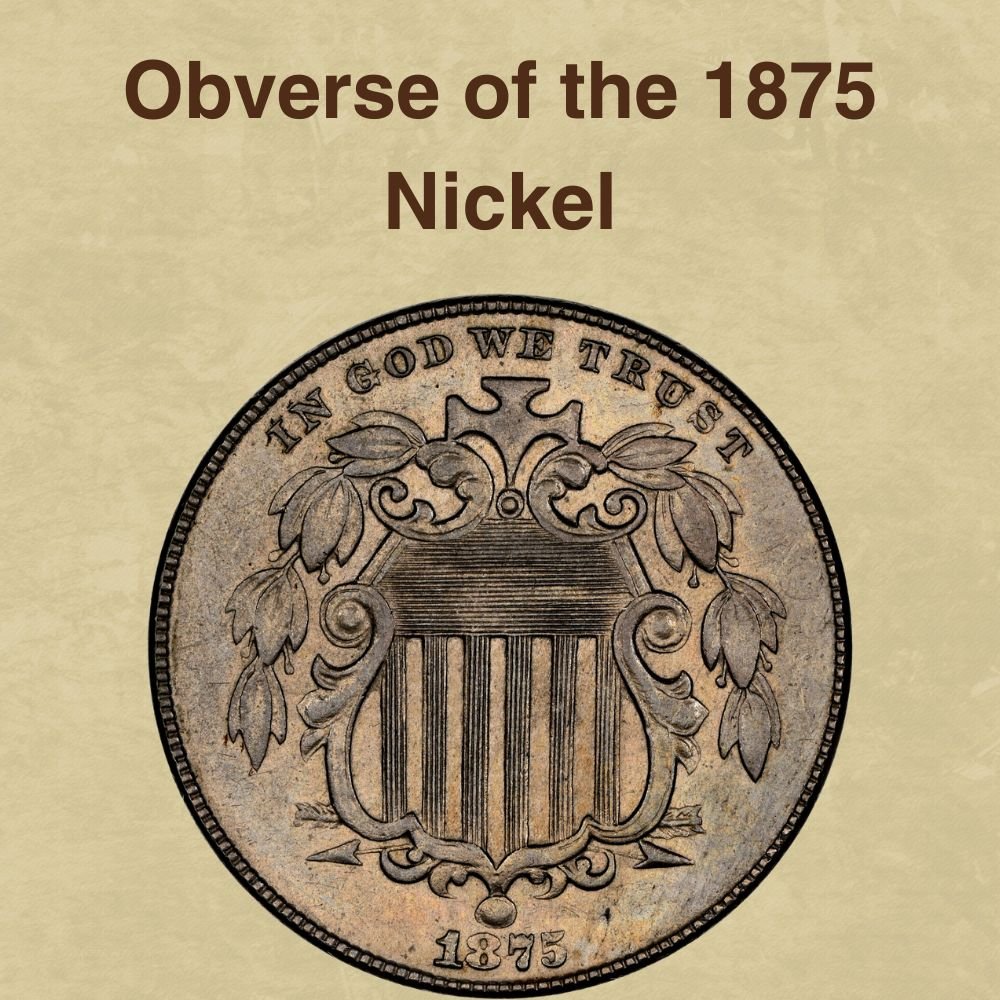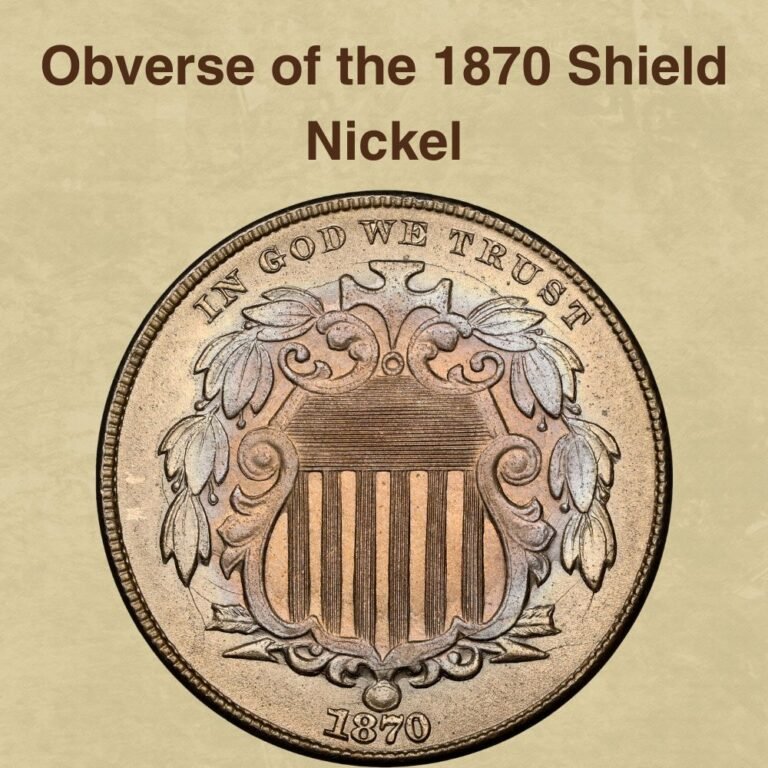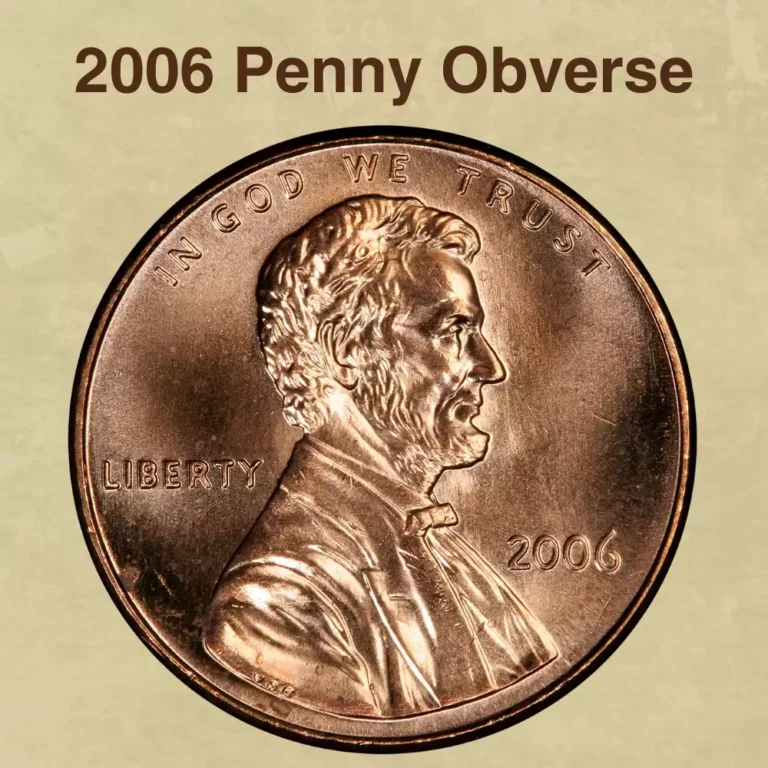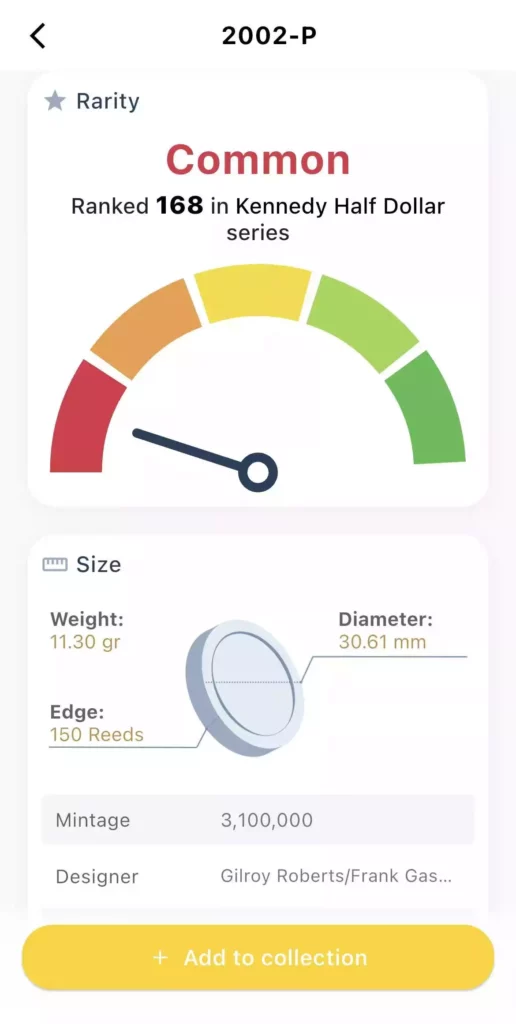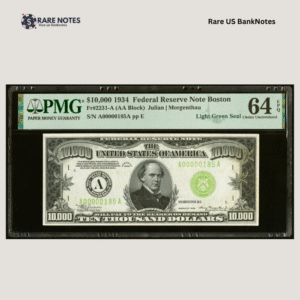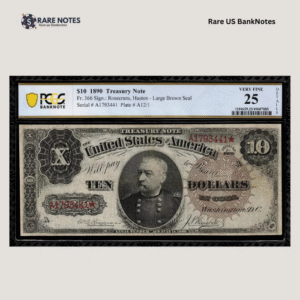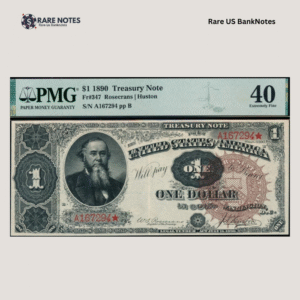Have you come across a 1875 nickel and wonder how much this classic coin is worth? Or maybe you’re building a collection of Shield Nickels and are curious about the 1875 nickel value, given its low mintage compared to earlier dates? Our guide answers all your questions about this old coin!
You’ll learn a little history about the Shield Nickel coinage, discover high-value minting errors, and learn insider tips and tricks for grading your nickel like a pro. More importantly, we’ll reveal the market value of the 1875 shield nickel and what to expect when collecting this coin.
So, let’s jump in and find out: How much is the 1875 Shield nickel worth today?
1875 Nickel Value Chart |
||||
| Mint Mark | Good | Fine | Extremely Fine | Uncirculated |
| 1875 Nickel Value | $60 | $120 | $210 | $5,500 |
| 1875 Proof Nickel Value | – | – | – | $3,850 |
History of the 1875 Nickel
The United States Mint struck the first copper-nickel five-cent coin in 1866 and continued its production until 1883, when the Shield Nickel design was replaced by the Liberty Head design. This was not the first time the Mint was striking a five-cent piece; production can be traced as far back as 1792, when these coins were struck in silver and known as half-dimes.
The Civil War had a catastrophic effect on American coinage, as many of the coins were wiped out of circulation. This forced the public to use fractional currency, postal stamps, and tokens for commerce. By 1864, as the worst effects of the war waned, Congress began restoring the lost coins into circulation. In the process, some coins were abolished, including the three-cent note. New currency, such as bronze cents and the two-cent pieces designed by John Longacre, was introduced into circulation. Despite their initial popularity, these coins disappeared from circulation once again, prompting Congress to authorize the Mint to strike three-cent pieces made of 75% copper and 25% nickel. These coins proved to be popular and would form the basis for the five-cent copper-nickel piece.
Initially, Mint Director James Pollock was skeptical about minting coins containing nickel, but changed his mind after witnessing the popularity of the three-cent piece. In 1865, Pollock prepared and presented a bill to Congress for the authorization of a five-cent copper-nickel coin that would replace the unpopular five-cent note. Pollock’s bill passed unopposed in May 1866, paving the way for production.
While Pollock’s bill was in Congress, the Mint’s Chief Engraver, John Longacre, began designing patterns for the new copper-nickel pieces. He based his pattern designs on the two-cent pieces he had made years earlier, a move that helped save time and enabled production to happen as quickly as possible. Even though Shield Nickels were generally well struck, early production encountered numerous difficulties, leading to a design change in 1867 that eliminated the sun rays on the reverse of the coin. While this eased the problem, it didn’t eliminate the production issues at the time.
By 1875, the production of Shield Nickels was on a steady decline. Enough had been produced to meet commercial demand, and the Mint saw no need to churn out large numbers of these coins. At this point, just enough coins needed to replace those damaged or lost were being minted. The 1875 issue does have a significantly lower mintage than previous years, but it isn’t considered a key date. That said, 1875 nickels are rare in Mint State and Gem condition and can command significant premiums, making them a valuable addition to your collection.
Also read: Top 10 Most Valuable Nickels Worth Money
Features of the 1875 Nickel
Next, let’s look at the standout features of the 1875 nickel, which can help with authenticating and grading your coin. By knowing these features, you’ll also be in a better position to spot shield nickels worth good money.
Here’s what to look out for:
Obverse of the 1875 Nickel
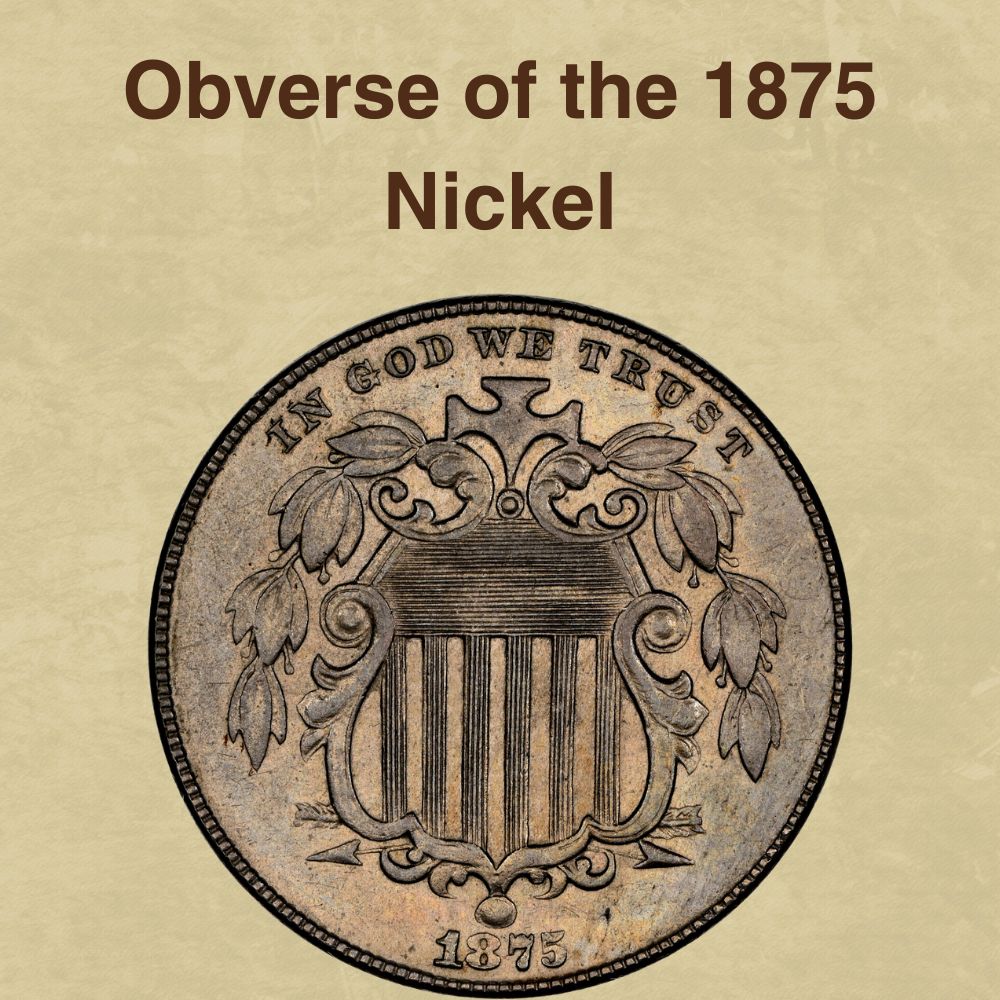
The “heads” shows an elaborate design featuring a shield from which the coin’s name is derived. The upper part of the shield, also known as the “chief’ is composed of horizontal lines, which represent the federal government, while the vertical stripes represent the state governments. The shield itself is symbolic of the unity of the states under the leadership of the federal government.
At the top of the shield is a cross or pattee, which symbolizes divine authority, while the laurel leaves hanging from both sides of the shield represent peace.
Two crossed arrows emerge from behind the shield at the bottom. These represent victory but are also symbolic of the country’s readiness to defend against aggression.
The national motto, IN GOD WE TRUST, is inscribed at the top along the rim, while the date, 1875, is shown at the bottom.
Reverse of the 1875 Nickel
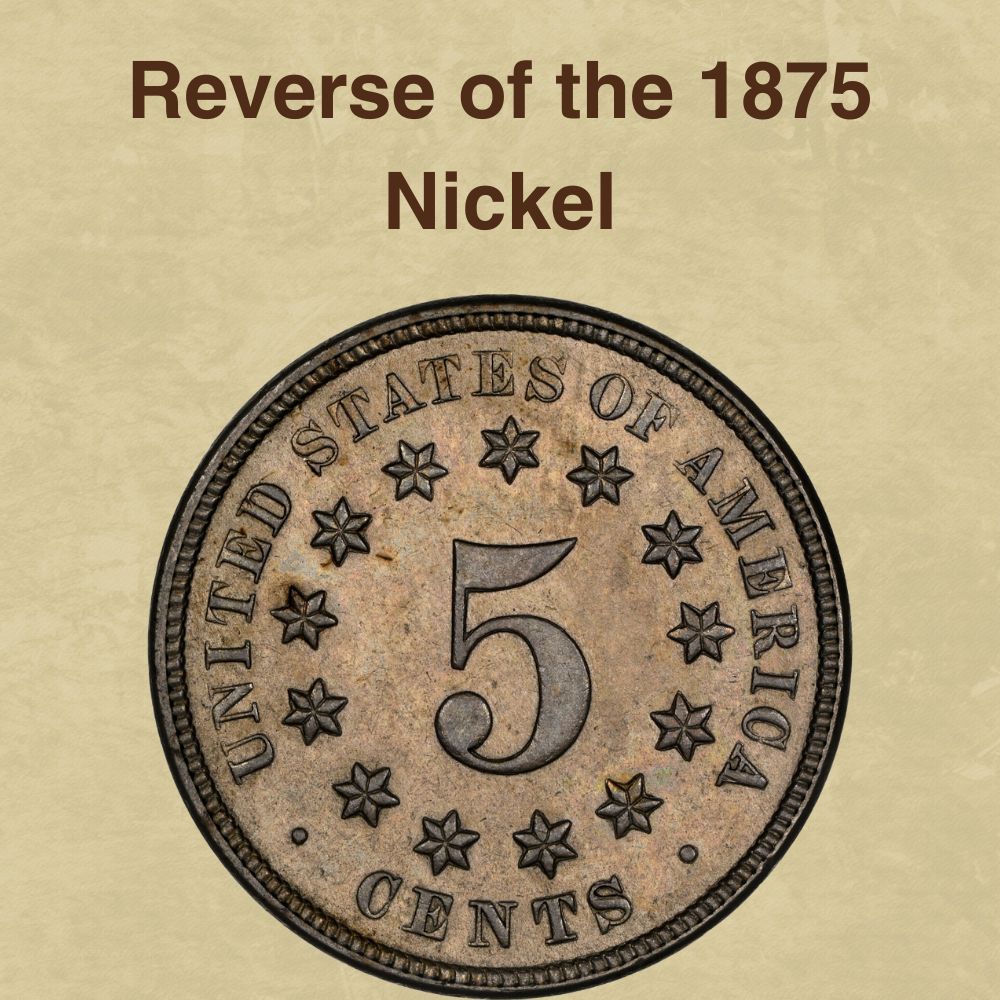
The “tails” shows the number 5 encircled by thirteen stars. The numeral represents the coin’s denomination, while the stars represent the thirteen states that first joined the Union.
The words UNITED STATES OF AMERICA are inscribed in an arc along the rim, while the coin’s denomination, CENTS, is etched at the bottom. The two words are separated by a period on each side of the coin’s surface.
Other Features of the 1875 Nickel
Additional features of the 1875 Shield Nickel worth noting are:
- Diameter: 20.5mm
- Weight: 5 grams
- Edge: Plain
- Metal Composition: 75% Copper, 25% Nickel
Also read: Top 17 Most Valuable Buffalo Nickel Worth Money
1875 Nickel Value Guides
Next, onto the big question: How much is a 1875 nickel worth? The market price depends on the coin’s condition, grade, and rarity. Unique minting errors and die varieties can also significantly increase the value of your shield nickel.
We’ll look at the two types of 1875 shield nickels:
- 1875 Shield Nickel (Regular Strike)
- 1875 Proof Shield Nickel
Let’s find out how much each is worth:
1875 Shield Nickel Value
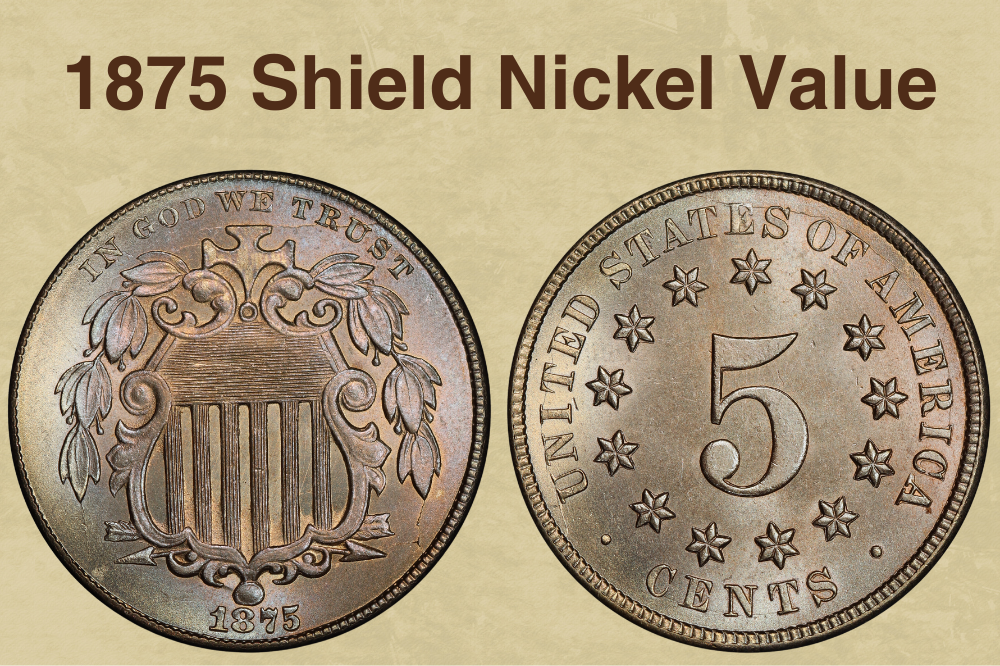
The Philadelphia Mint struck about 2,097,000 shield nickels in 1875. This issue had one of the lowest mintages in the series compared to earlier issues. By this time, there were enough five-cent pieces to meet commercial demand, and the Mint began slowing down the production of new coins. Circulated pieces are relatively common, but Mint State examples are genuinely scarce and are barely enough to meet collectors’ demand.
Here’s a breakdown of the value of a 1875 shield nickel:
- Circulated Example: Worn examples are quite common and affordable in all grades for most collectors. In Poor/Average condition, an example can sell for about $40 and as much as $60 in Good (G) condition. Fine (F) examples can fetch up to $120, while in Extremely Fine (XF), prices can go as high as $210. About Uncirculated (AU) examples are relatively commonplace despite this issue’s low mintage. These examples are well-struck and are the most desirable of the circulated survivors. In AU58, pieces can sell for as much as $370.
- Mint State Example: These are scarce in lower grades and genuinely difficult to find in higher grades or Gem condition. Most survivors are graded MS63-MS64, followed by a few examples in MS65. Gems finer than MS65 are rare and usually command significant premiums. In MS60, examples can sell for as much as $400, up to $500 in MS62, and at least $675 in MS63. Examples in MS64 are few and far apart, often commanding at least $1,200, while rare Gems in MS65 can sell for over $2,400. A few known examples are graded MS66, and their prices start from about $5,500.
- Auction Record: In a 2004 sale, Heritage Auctions sold a rare MS66 for a record-shattering $8,400, making this one of the most valuable regular strike 1875 shield nickels.
1875 Proof Shield Nickel Value
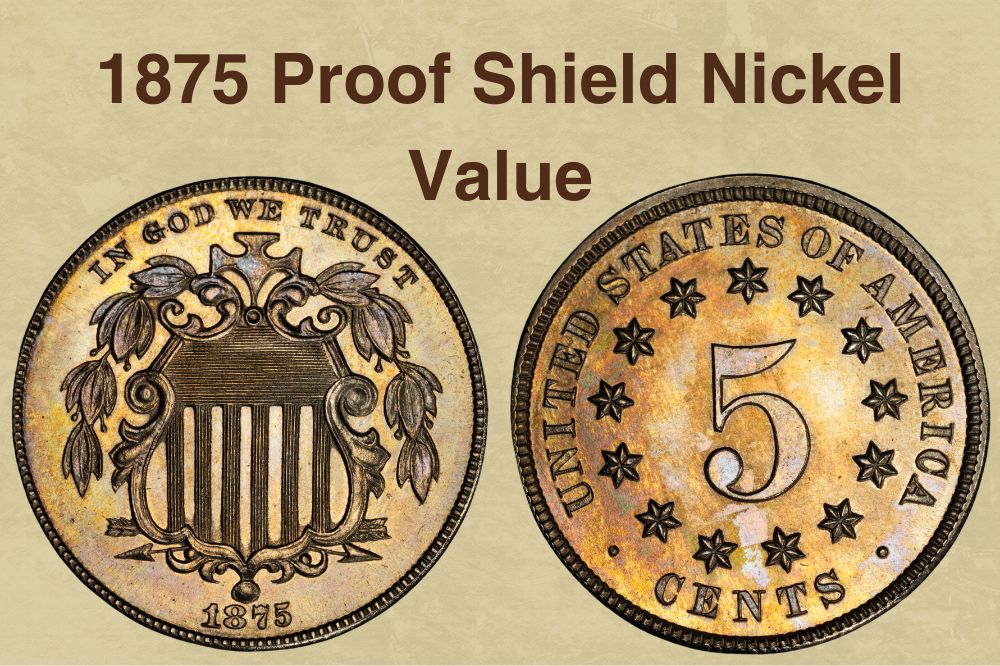
In addition to the regular strike five-cent pieces, the Mint struck 700 proofs in 1875, which were included in that year’s silver proof set. Most shield nickel proofs struck in the 1870s display poor strike, graininess, and a less-than-brilliant luster, which isn’t what you’d expect of proof coins. Although regular examples are common, real gems are extremely rare to find.
Here’s what to expect when collecting a 1875 proof shield nickel:
- Regular Proofs: These are common and fairly accessible to most collectors, even in higher grades. For instance, a PF60 example will set you back about $235, while a PF62 is worth at least $340. In PF64 examples can sell for up to $650, while in PF66 prices fall in the $1350-$1,500 range. In 2020, Legend Rare Coin Auctions sold a PR67+ for a record-breaking $9,988.
- Cameos: Cameo pieces are less common than their regular proof counterparts, although still collectible. Survivors are clustered around grades PF64 to PF65, where prices start at $725 for PF64 examples to at least $1,300 for PF65 specimens. Gems in PF66 are a true rarity, although a few examples exist, with prices starting from $2,750. Examples in PF67 and higher are genuinely hard to find; the rare PF68 survivor can command premiums of up to $9,400. In a record-shattering sale in 2014, Stack’s Bowers sold a PFCAM67 for an impressive $9,988.
So, 1875 shield nickels are quite valuable, even in lower grades, but Mint State examples will offer the best premiums. Whether buying or selling, a 1875 shield nickel offers great value.
Also read: Top 17 Most Valuable Jefferson Nickels Worth Money
1875 Nickel Grading
When grading a 1875 nickel, carefully examine the key features that are prone to wear. On the obverse, these include the shield’s vertical and horizontal stripes, laurel leaves, cross, motto, and date. Check the number 5, stars, and denomination for the extent of wear. Extensive wear, weak outlines, almost invisible details, and a dull surface point to a lower-grade coin. Higher grade nickels will display bold outlines, crisp details, little or no wear or surface, and brilliant mint luster.
Check out this video for more tips on accurately grading your Shield Nickels.
Rare 1875 Nickel Errors List
Although the 1875 shield nickel was well-struck with few anomalies, some notable minting errors do show up in this series. These are the exception rather than the norm and can therefore add significant value to your shield nickel.
Here are 1875 nickel errors worth good money:
1. 1875 Nickel Die Crack Error
Despite being well-struck, die cracks seem to be a common occurrence on 1870s nickels, including the 1875 issue. This error occurs when cracks form on the die’s surface and are gradually filled with small metal pieces as the die continues to be used.
Eventually, the die impresses the metal-filled cracks on the planchet, leaving raised bumps that appear like cracks on the coin’s surface. Larger, dramatic die cracks are generally more valuable and can fetch as much as $20-$100 or more. In 2015, a collector on eBay paid an impressive $480 for an MS60 with a large die crack across the shield.
2. 1875 Nickel Re-Punched Date Error
Some 1875 nickels will show a re-punched date error where the date digits appear to have a ghost outline or some doubling. This happens as a result of the date being punched multiple times at slightly different angles into the working die, causing the visible doubling of the digits. A re-punched date error is worth about $20-$50 or more, depending on the intensity of the doubling.
3. 1875 Nickel Clipped Planchet Error
Another error that comes up in this series is the clipped planchet, which occurs when the planchet is incorrectly cut from the metal strip, resulting in a missing portion of the edge.
Clips can be curved, straight, or jagged, with larger ones being more eye-catching and valuable. A clipped planchet error is worth as much as $50-$150 or more. For example, in 2020, a collector on eBay paid $485 for an AU58 with a straight clipped error.
Also read: 14 Most Valuable Nickel Errors Worth Money
FAQs
How much is a 1875 nickel worth?
The 1875 nickel value depends on the coin’s condition and rarity. These coins are generally well-struck, and many survivors are generally in good condition. Circulated examples are worth between $40 and $370, while the Mint State pieces, which are relatively rare, will fetch between $400 on the lower end of the grade to as much as $5,500 for the finest examples.
How do I know if my 1875 nickel is valuable?
The most valuable 1875 nickels are in uncirculated Mint State condition. These coins have brilliant, original mint luster, strong, crisp details, and show no wear or surface damage. Such 1875 nickels are, however, rare and command significant premiums. If you think you have a Mint State 1875 nickel, you can have it authenticated by trusted bodies such as the Professional Coin Grading Service (PCGS) or the Numismatic Guaranty Company (NGC).
Is a 1875 nickel rare?
Circulated 1875 nickels are not rare, although they can be scarce in higher grades. However, Mint State examples are genuinely scarce and become rarer higher up the grading scale.
Market Interest Trend Chart
if (window.innerWidth <= 480) {
canvas.height = 250;
} else if (window.innerWidth <= 768) {
canvas.height = 300;
} else {
canvas.height = 400;
}
var ctx = canvas.getContext(“2d”);
var fullLabels = [“09/2015″,”10/2015″,”11/2015″,”12/2015″,”01/2016″,”02/2016″,”03/2016″,”04/2016″,”05/2016″,”06/2016″,”07/2016″,”08/2016″,”09/2016″,”10/2016″,”11/2016″,”12/2016″,”01/2017″,”02/2017″,”03/2017″,”04/2017″,”05/2017″,”06/2017″,”07/2017″,”08/2017″,”09/2017″,”10/2017″,”11/2017″,”12/2017″,”01/2018″,”02/2018″,”03/2018″,”04/2018″,”05/2018″,”06/2018″,”07/2018″,”08/2018″,”09/2018″,”10/2018″,”11/2018″,”12/2018″,”01/2019″,”02/2019″,”03/2019″,”04/2019″,”05/2019″,”06/2019″,”07/2019″,”08/2019″,”09/2019″,”10/2019″,”11/2019″,”12/2019″,”01/2020″,”02/2020″,”03/2020″,”04/2020″,”05/2020″,”06/2020″,”07/2020″,”08/2020″,”09/2020″,”10/2020″,”11/2020″,”12/2020″,”01/2021″,”02/2021″,”03/2021″,”04/2021″,”05/2021″,”06/2021″,”07/2021″,”08/2021″,”09/2021″,”10/2021″,”11/2021″,”12/2021″,”01/2022″,”02/2022″,”03/2022″,”04/2022″,”05/2022″,”06/2022″,”07/2022″,”08/2022″,”09/2022″,”10/2022″,”11/2022″,”12/2022″,”01/2023″,”02/2023″,”03/2023″,”04/2023″,”05/2023″,”06/2023″,”07/2023″,”08/2023″,”09/2023″,”10/2023″,”11/2023″,”12/2023″,”01/2024″,”02/2024″,”03/2024″,”04/2024″,”05/2024″,”06/2024″,”07/2024″,”08/2024″,”09/2024″,”10/2024″,”11/2024″,”12/2024″,”01/2025″,”02/2025″,”03/2025″,”04/2025″,”05/2025″,”06/2025″,”07/2025″,”08/2025”];
var monthNames = [“September 2015″,”October 2015″,”November 2015″,”December 2015″,”January 2016″,”February 2016″,”March 2016″,”April 2016″,”May 2016″,”June 2016″,”July 2016″,”August 2016″,”September 2016″,”October 2016″,”November 2016″,”December 2016″,”January 2017″,”February 2017″,”March 2017″,”April 2017″,”May 2017″,”June 2017″,”July 2017″,”August 2017″,”September 2017″,”October 2017″,”November 2017″,”December 2017″,”January 2018″,”February 2018″,”March 2018″,”April 2018″,”May 2018″,”June 2018″,”July 2018″,”August 2018″,”September 2018″,”October 2018″,”November 2018″,”December 2018″,”January 2019″,”February 2019″,”March 2019″,”April 2019″,”May 2019″,”June 2019″,”July 2019″,”August 2019″,”September 2019″,”October 2019″,”November 2019″,”December 2019″,”January 2020″,”February 2020″,”March 2020″,”April 2020″,”May 2020″,”June 2020″,”July 2020″,”August 2020″,”September 2020″,”October 2020″,”November 2020″,”December 2020″,”January 2021″,”February 2021″,”March 2021″,”April 2021″,”May 2021″,”June 2021″,”July 2021″,”August 2021″,”September 2021″,”October 2021″,”November 2021″,”December 2021″,”January 2022″,”February 2022″,”March 2022″,”April 2022″,”May 2022″,”June 2022″,”July 2022″,”August 2022″,”September 2022″,”October 2022″,”November 2022″,”December 2022″,”January 2023″,”February 2023″,”March 2023″,”April 2023″,”May 2023″,”June 2023″,”July 2023″,”August 2023″,”September 2023″,”October 2023″,”November 2023″,”December 2023″,”January 2024″,”February 2024″,”March 2024″,”April 2024″,”May 2024″,”June 2024″,”July 2024″,”August 2024″,”September 2024″,”October 2024″,”November 2024″,”December 2024″,”January 2025″,”February 2025″,”March 2025″,”April 2025″,”May 2025″,”June 2025″,”July 2025″,”August 2025”];
var gradient = ctx.createLinearGradient(0, 0, 0, canvas.height);
gradient.addColorStop(0, “rgba(62, 154, 229, 0.3)”);
gradient.addColorStop(1, “rgba(62, 154, 229, 0.01)”);
new Chart(ctx, {
type: “line”,
data: {
labels: [“09/2015″,””,””,””,””,””,””,””,””,””,””,””,””,””,””,””,””,””,””,””,””,””,””,””,””,””,””,””,””,””,””,””,””,””,””,””,””,””,””,””,””,””,””,””,””,””,””,””,””,””,””,””,””,””,””,””,””,””,””,””,””,””,””,””,””,””,””,””,””,””,””,””,””,””,””,””,””,””,””,””,””,””,””,””,””,””,””,””,””,””,””,””,””,””,””,””,””,””,””,””,””,””,””,””,””,””,””,””,””,””,””,””,””,””,””,””,””,””,””,”08/2025″],
datasets: [{
label: “Volume”,
data: [0,0,0,3370,3370,4490,1120,1120,0,0,0,0,0,0,1120,1120,1680,560,1120,560,560,560,2240,2800,2800,1120,560,0,0,0,0,0,0,0,0,0,560,560,560,0,1680,3370,3370,1680,1680,1680,1680,0,270,160,160,270,350,270,160,270,200,350,270,200,160,240,210,270,250,210,570,570,370,290,220,290,460,270,340,380,580,350,510,220,380,460,360,700,380,480,260,430,320,230,250,370,440,280,470,260,410,160,190,250,520,610,560,290,160,180,420,350,470,240,260,330,590,690,640,370,240,260,500,430],
borderColor: “#3e9ae5”,
backgroundColor: gradient,
borderWidth: 3,
fill: true,
tension: 0.4,
pointRadius: 0,
pointHoverRadius: 6,
pointBackgroundColor: “#3e9ae5”,
pointBorderColor: “#fff”,
pointBorderWidth: 2,
pointHoverBackgroundColor: “#3e9ae5”
}]
},
options: {
responsive: true,
maintainAspectRatio: false,
interaction: {
mode: “index”,
intersect: false
},
layout: {
padding: {
left: 0,
right: 0,
top: 10,
bottom: 10
}
},
scales: {
x: {
title: {
display: false
},
grid: {
display: false,
drawBorder: false
},
ticks: {
autoSkip: false,
maxRotation: 0,
minRotation: 0,
padding: 5,
font: {
size: window.innerWidth < 768 ? 10 : 12,
color: “#6b7280”
}
}
},
y: {
title: {
display: false
},
position: “left”,
beginAtZero: true,
min: 0,
max: 5000,
grid: {
display: true,
color: “rgba(0, 0, 0, 0.06)”,
drawBorder: false,
drawTicks: false
},
ticks: {
stepSize: (function() {
var range = 5000;
var step = range / 10;
if (step > 50000) {
step = Math.ceil(step / 10000) * 10000;
} else if (step > 20000) {
step = Math.ceil(step / 5000) * 5000;
} else if (step > 10000) {
step = Math.ceil(step / 2000) * 2000;
} else if (step > 5000) {
step = Math.ceil(step / 1000) * 1000;
} else if (step > 1000) {
step = Math.ceil(step / 500) * 500;
} else if (step > 100) {
step = Math.ceil(step / 100) * 100;
} else {
step = Math.ceil(step / 10) * 10;
}
return step;
})(),
padding: 10,
font: {
size: window.innerWidth < 768 ? 10 : 12,
color: “#6b7280”
},
callback: function(value, index, values) {
if (value >= 1000) {
return (value / 1000).toFixed(0) + “k”;
}
return Math.round(value);
}
}
}
},
plugins: {
legend: {
display: false
},
tooltip: {
mode: “index”,
intersect: false,
backgroundColor: “rgba(0, 0, 0, 0.8)”,
titleColor: “#fff”,
bodyColor: “#fff”,
borderColor: “#3e9ae5”,
borderWidth: 1,
padding: 10,
cornerRadius: 4,
displayColors: false,
callbacks: {
title: function(context) {
var index = context[0].dataIndex;
return monthNames[index];
},
label: function(context) {
var value = context.parsed.y;
return “Volume: ” + value.toLocaleString();
}
}
}
}
}
});
}
} else {
console.error(“Chart.js not loaded”);
}
});
The post 1875 Nickel Coin Value: How Much Is It Worth Today? appeared first on CoinValueChecker.com.


